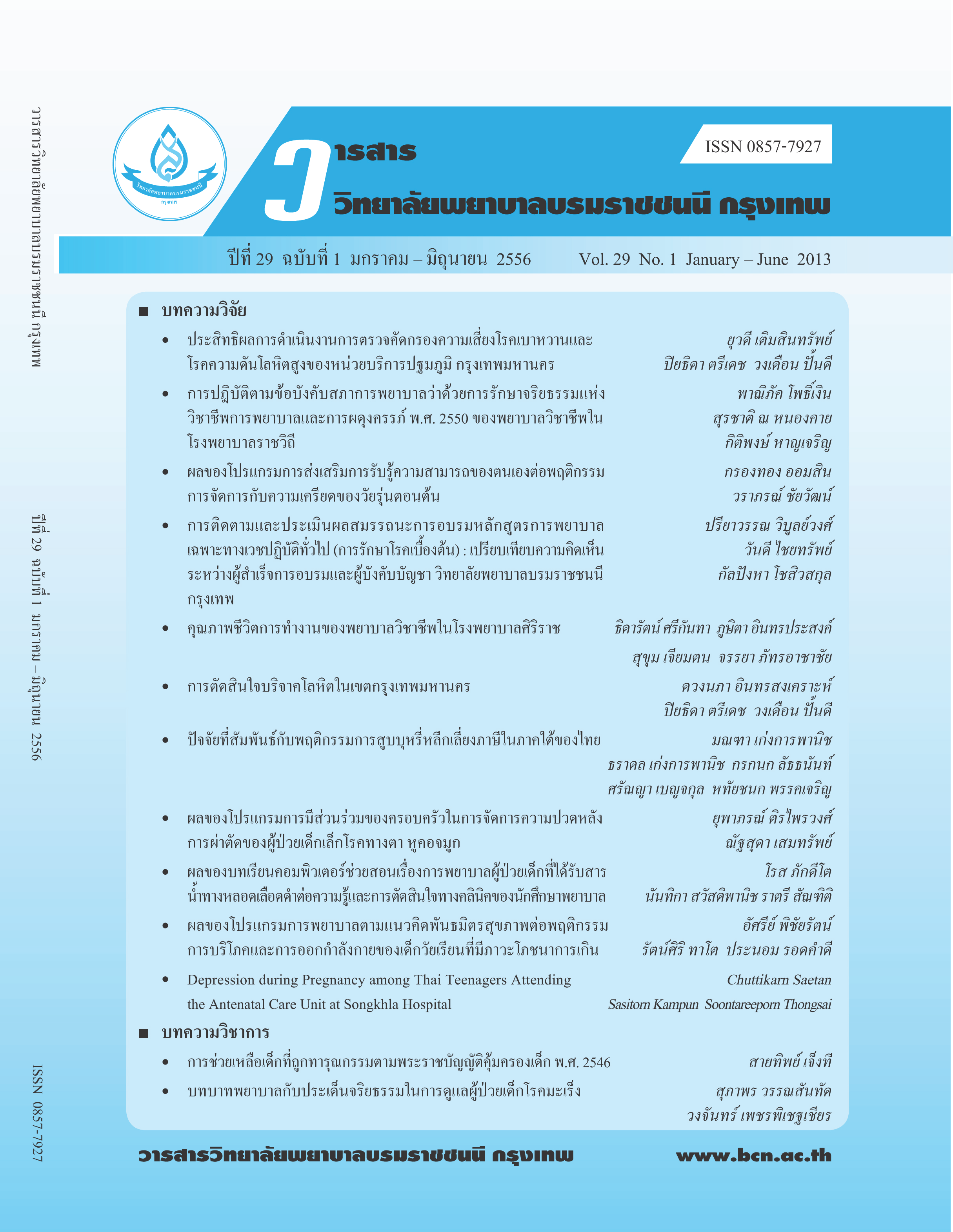ปัจจัยที่สัมพันธ์กับพฤติกรรมการสูบบุหรี่หลีกเลี่ยงภาษีในภาคใต้ของไทย Factors Related to Tax Avoidant Cigarette Smoking in the South of Thailand
คำสำคัญ:
บุหรี่หลีกเลี่ยงภาษี, ผู้สูบบุหรี่ปัจจุบัน, ภาคใต้ของไทย, Tax Avoidant Cigarettes, Current Smokers, the South of Thailandบทคัดย่อ
บทคัดย่อ
การสูบบุหรี่หลีกเลี่ยงภาษีเป็นปัญหาสำคัญต่อการควบคุมยาสูบของประเทศไทย การวิจัยสำรวจแบบภาคตัดขวางนี้มีวัตถุประสงค์เพื่อศึกษาพฤติกรรมการสูบบุหรี่หลีกเลี่ยงภาษี และปัจจัยทำนายพฤติกรรมการสูบบุหรี่หลีกเลี่ยงภาษีของผู้สูบบุหรี่ปัจจุบันในภาคใต้ของไทย พื้นที่เป้าหมาย 8 จังหวัดของภาคใต้ที่มีอัตราการสูบบุหรี่สูง ได้แก่ ปัตตานี สตูล สงขลา พัทลุง พังงา ระนอง ภูเก็ต และสุราษฎร์ธานี โดยศึกษาในผู้สูบบุหรี่ปัจจุบันที่มีอายุ 18 ปีขึ้นไปในเขตเทศบาล/เขตเมือง เลือกตัวอย่างแบบเป็นระบบได้จำนวน 2,048 ตัวอย่าง เก็บรวบรวมข้อมูลด้วยการสัมภาษณ์และเก็บซองบุหรี่ ระหว่างเดือนมีนาคมถึงมิถุนายน 2554 วิเคราะห์ความแตกต่างของสัดส่วนด้วยค่า 95%CI สำหรับปัจจัยที่มีความสัมพันธ์และทำนายพฤติกรรมการสูบบุหรี่ด้วยสถิติ Binary Logistic Regression
การศึกษาพบว่า ผู้สูบบุหรี่ปัจจุบันในภาคใต้สูบบุหรี่หลีกเลี่ยงภาษีร้อยละ 16.0 โดยพิจารณาจากซองบุหรี่ที่ไม่ติดอากรแสตมป์ไทย คุณลักษณะของผู้ที่สูบบุหรี่หลีกเลี่ยงภาษีเป็นผู้หญิงสูบมากกว่าผู้ชายร้อยละ3 ช่วงอายุระหว่าง 18-24 ปีสูบมากที่สุด เมื่อเปรียบเทียบความแตกต่างกันอย่างมีนัยสำคัญทางสถิติที่ระดับ 95% พบว่าผู้สูบที่จบประถมศึกษาสูบบุหรี่หลีกเลี่ยงภาษีมากกว่ากลุ่มระดับการศึกษาสูง กลุ่มคนจนที่สุดสูบบุหรี่หลีกเลี่ยงภาษีที่มากกว่ากลุ่มฐานะอื่นๆ และผู้สูบของจังหวัดปัตตานีสูบมากกว่าทุกๆจังหวัด รองลงมาคือจังหวัดสตูล โดยร้อยละ 76.9 ซื้อบุหรี่หลีกเลี่ยงภาษีครั้งล่าสุดจากร้านขายของชำ รองลงมาคือ ตลาดมืด และพ่อค้าเร่ จากการศึกษาพบ 7 ปัจจัยที่มีความสัมพันธ์และสามารถทำนายพฤติกรรมการสูบบุหรี่หลีกเลี่ยงภาษีของผู้สูบบุหรี่ปัจจุบันอายุ 18 ปีขึ้นไปในภาคใต้ เรียงตามปัจจัยที่มีอิทธิพลมากไปน้อยเมื่อควบคุมอิทธิพลของปัจจัยอื่นๆดังนี้ คือ 1) การรับรู้ว่าบุหรี่ที่ซื้อล่าสุดเป็นบุหรี่ไม่เสียภาษี 2) จังหวัด 3) การรับรู้ว่าบุหรี่ที่จำหน่ายบริเวณรอบที่อยู่อาศัยเป็นบุหรี่ไม่เสียภาษี 4) ความพยายามในการซื้อบุหรี่ราคาถูกกว่าปกติใน 6 เดือนที่ผ่านมา 5) อาชีพ 6) สถานภาพทางเศรษฐกิจ และ 7) กลุ่มอายุ ซึ่งทั้ง 7 ปัจจัยสามารถร่วมกันทำนายพฤติกรรมสูบบุหรี่หลีกเลี่ยงภาษีได้ร้อยละ 40.8 ดังนั้น หน่วยงานที่มีหน้าที่ต้องร่วมกันปราบปราบการลักลอบบุหรี่หนีภาษีอย่างเคร่งครัด อีกทั้งควรมีมาตรการอื่นควบคู่ไปด้วย อาทิ การบังคับใช้กฎหมายอย่างเคร่งครัด การขึ้นภาษีอย่างต่อเนื่อง การปรับแก้กฎหมายให้เพิ่มบทลงโทษการละเมิด การรณรงค์ให้ความรู้แก่เยาวชน และพัฒนาระบบการเฝ้าระวังบุหรี่หนีภาษีในพื้นที่ เพื่อลดพฤติกรรมการสูบบุหรี่หลีกเลี่ยงภาษี
Abstract
Tax avoidant cigarette smoking has affected on tobacco control in Thailand. This cross-sectional study aimed to study the tax avoidant cigarette smoking and predicting factors of the tax avoidant cigarette smoking among current smokers in the south of Thailand. Target groups were current smokers aged 18 years and over, living in municipal or urban areas, in eight provinces of the south; Pattani, Satul, Songkhla, Phangha, Ranong, Phuket and Suratthani. Samples were selected by systematic sampling with listing and data collection. Data were collected by face to face interview and cigarette pack gathering from 2,048 samples during March to June, 2011 and analyzed for the factors affecting on tax avoidant cigarette smoking by Binary Logistic Regression.
The results showed 16% of current smokers smoked tax avoidant cigarettes, considered by examining the tax stamp on the packs. The traits of tax avoidant cigarette smokers were significantly high among female (higher than male for 3%), the lower age, student, and low to moderate income groups. The three provinces which found highly use of tax avoidant cigarettes were Pattani, Satul and Songkhla. Nearly 77% of tax avoidant cigarette smokers purchased the last cigarettes from grocery shops, black market and hawkers. The results revealed seven factors affecting on the tax avoidant cigarettes smoking from high to low effect. They were: 1) perceived the last cigarette purchase was tax avoidant cigarettes 2) province 3) perceived that cigarette selling around residence was tax avoidant cigarettes 4) tried to buy cheaper cigarette than normal cigarette in the past 6 months 5) occupation 6) economic status and 7) age group. These seven co-factors could predict the illicit cigarette smoking for 40.8%.
These results recommend the related organization to join to strictly subdue the cigarette smuggling, including execute the other measures together such as strictly law enforcement, continuous tax increase, adjustment of law to increase the punishment of violation, health education to youth, and development of surveillance system for tax avoidant cigarettes.
Downloads
เผยแพร่แล้ว
How to Cite
ฉบับ
บท
License
บทความที่ได้รับการตีพิมพ์ เป็นลิขสิทธิ์ของวารสารวิจัยสุขภาพและการพยาบาล (วิทยาลัยพยาบาลบรมราชชนนี กรุงเทพ) ไม่สามารถนำไปตีพิมพ์ซ้ำในวารสารฉบับอื่น

















